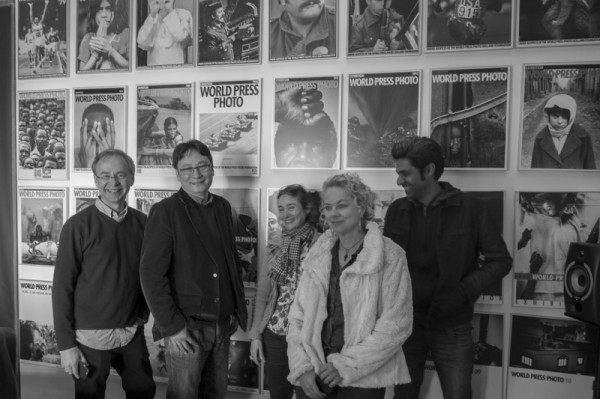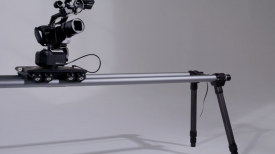By site editor Dan Chung:
Bob Sacha on 'Behind the Video of Eric Garner's Deadly Confrontation With New York Police' from World Press Photo on
Vimeo.
Today World Press Photo announced the winners of their annual multimedia awards. This year, there were two categories for linear productions – a short feature and a long feature. There were also awards for interactives. Unlike previous years there was no requirement to have stills included in the video, although several winning entries did.
This year I was asked to be on the jury for the short and long feature categories. I spent five days in Amsterdam looking at nearly three hundred video entries with my fellow judges. The panel for the linear video awards was chaired by Marianne Levy-Leblond of French broadcaster ARTE and included Pulitzer prize winner Barbara Davidson of the LA Times, Bob Sacha of the Graduate School of Journalism at the City University of NY, Hussain Currimbhoy of the Sundance institute and myself. It was an honour to serve with such a diverse and esteemed panel who brought wisdom and experience from different parts of the industry.
The first prize in the short feature category went to Time for their video “Behind the Video of Eric Garner’s Deadly Confrontation With New York Police”, which featured the work of citizen journalist Ramsey Orta. He captured Eric Garner’s arrest and subsequent death on his cell phone. Time interviewed Orta and used his video to give a compelling account of the events.
The second prize was awarded to Ben C Solomon of the New York Times, who documented ambulance nurse Gordon Kamara and his crew at the height of the Ebola outbreak in September 2014. The video immerses the viewer into the heart of the battle against the disease in Monrovia.
Barbara Davidson on 'Fighting Ebola Outbreak Street by Street' from World Press Photo on Vimeo.
Third prize in the short features went to ‘At the gates of Europe’ shot by Carlos Spottorno and scripted by Guillermo Abril. It highlights the growing numbers of immigrants trying to enter Europe by boat across the Mediterranean sea. Thousands die during the perilous voyages and the Italian navy set up control, search and rescue operations as part of Operation Mare Nostrum. Spottorno was given unique access to document it.
The Long Night – Trailer from MediaStorm on Vimeo.
In the long feature section MediaStorm picked up two of the three awards. The first was by Tim Matsui, who won first prize with his moving series ‘The Long Night’ which explores the crisis of minors entangled in the American sex trade. Produced and edited by Tim McLaughlin and exec produced by Brian Storm, the series is the result of a long documentary project by the highly committed Matsui.
Hussain Currimbhoy on 'The Long Night' from World Press Photo on Vimeo.
The second prize went to ‘The Fence’, a beautifully crafted piece that looks at the border between the US and Mexico through stunning stills mixed with subtle video. It was filmed and directed by Charles Ommanney and edited by Andrew Hida.
Hussain Currimbhoy on 'The Fence' from World Press Photo on Vimeo.
Third was another MediaStorm production, this time focussing on workers in Japan. “Japan’s Disposable Workers: Net Café Refugees” was shot by Shiho Fukada and edited and produced by Eric Maierson. Brian Storm was again exec producer.
The first prize in the interactive category went to {The And} – an interactive documentary that explores the dynamics of modern relationships by bringing the viewer into the emotional space of real life couples. It was created by director/writer Topaz Adizes and creative director/Writer: Nathan Phillips.
Marianne Lévy-Leblond on judging the 2015 Multimedia Contest from World Press Photo on Vimeo.
Overall, the standard of entries I saw was very proficient. It is clear to me that video by newspapers and web news portals is much better than it has ever been. The storytelling, journalism, editing and camera technique has improved – although it was also clear that the linear video field is led by a handful of US news organisations, perhaps because they having been investing more in video and making greater efforts to produce each piece than their rivals.
I felt the camerawork on most of the entries still reflected the photojournalistic roots of many of the entrants – much of it was very static or used very basic movements. Aesthetics were of course not the only criteria for awarding the winners and ultimately the power of the story and good storytelling were crucial deciding factors. This was certainly the case for “Behind the Video of Eric Garner’s Deadly Confrontation With New York Police”. I felt that the video shot by Ramsey Orta, combined with the careful way with which the TIME team crafted the video, was a worthy winner even though it centred on an act of citizen journalism.
The list of winners and more background information you can visit the World Press Photo website.






